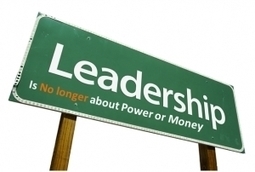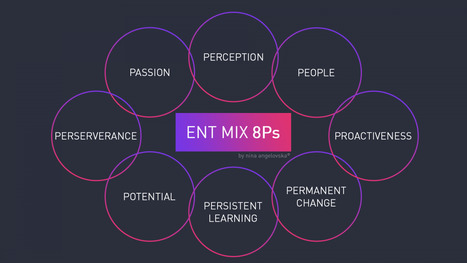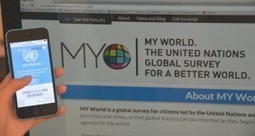 Your new post is loading...
 Your new post is loading...

|
Scooped by
nrip
|
What does it take to be an extraordinary entrepreneur? You know, an entrepreneur who has a vision for a business, rallies support to build it and then grows it into one of the most innovative companies in the world….what does it take to be an entrepreneur like that? Belief #1: Make a decision and go! Belief #2: Show passion, not perfection Belief #3: Avoid the ugly baby syndrome Belief #4: Find the sweet spot, then scale it Belief #5: Don’t think about taking a leap, just take it Belief #6: Entrepreneurship isn’t a war, it’s about solving problems and turning a profit Belief #7: Hire slow, fire fast Belief #8: Learn from your first, earn from your second, give back with your third

|
Scooped by
nrip
|
Difficult conversations tend to be the most stressful of all workplace aggravations. These are the types of talks that require you to deliver bad news or negative feedback, make a demand such as asking for a raise or more responsibility, apologize for a mistake, or otherwise have a conversation that you dread. Difficult conversations intensify our emotionality because our minds perceive them as a threat. To the primal parts of our emotional brain, the worry of being disliked or losing standing is akin to being ousted from the group and causes real pain. You don’t need to let anxiety and frustration overtake your negotiation and rationale skills. Here’s how to keep the flood of emotions at bay during difficult conversations so you can show up as your best self. Strategize your approach Make high-level, headline-like markers that can guide you if you lose your train of thought. Determine what you want to get out of the conversation. Your goal should be realistic and achievable. Planning to “win” is a losing battle. Rally your resilience Positive visualization can be effective. Approach the conversation as a collaboration Diffuse the emotional charge by listening first. Ask open-ended Try a mantra Studies show that repeating a single word or phrase silently to yourself can quiet your mind. Beware of emotional contagion

|
Scooped by
nrip
|
Get ready for the light at the end of the tunnel. Thats the message that Pantome seems to have decided to send out in picking 2 colours which will will dominate the coming year (2021) as per them. The colors included in this year’s set of Pantone Color of the Year 2021 are PANTONE 17-5104 Ultimate Gray and PANTONE 13-0647 Illuminating. The yellow is also RGB 245, 223, 77, while the gray is also RGB 147, 149, 151. The chosen shades will give us a feeling of energy, strength and positivity in the face of the uncertainty that 2020 leaves, according to Leatrice Eiseman, executive director of the Pantone Color Institute. There is general agreement on very little in today's opinionated and noise filled social media driven word , but for the common opinion that 2020 has been a bit of a shit show, and we cant wait to see welcome 2021 to clean up the energies on this world. That makes this selection of 2 colors apt for the coming year. Get ready for Ultimate Gray and Illuminating - The light at the end of the tunnel. curated from https://www.slashgear.com/pantone-color-of-the-year-is-illuminating-yellow-definitely-not-for-cyberpunk-2077-09650474/ and https://www.nytimes.com/2020/12/09/style/pantone-color-2021-ultimate-gray-illuminating.html

|
Scooped by
nrip
|
Elastic thinking is about stretching your mind and using “bottom up” processing in the brain rather than the top down executive functions that drive analytical thinking. “Those who cannot change their minds cannot change anything,” George Bernard Shaw said that. And Einstein also said, “The measure of intelligence is the ability to change.” Life is neither static nor unchanging, it’s fluid. Nothing stays the same. Elastic thinking (experts may call it cognitive flexibility) allows us to shift gears and think about something in more than one way. A fixed mindset can sabotage your efforts to thrive in a changing environment. How elastic is your brain? The ability to stretch beyond your core strengths when necessary and quickly rebound back to your core skills and discipline is a desirable trait. Elasticity is essentially responsiveness to change in an ever-changing world. To survive in an environment of constant stimulation and rapid change, elastic thinking is essential. Elasticity is flexibility. It’s the ability to adapt to new situations, break down complex tasks into bite size chunks, improvise, and shift strategies to meet different types of challenges. Flexibility gives the human brain the edge over computers is flexible thinking. Elastic minds are people who reimagine new ways to solve existing problems and create tools make things better, easier, faster and smarter. The best innovators can quickly shift their perspective. “Our new role as visionaries, decision makers, and strategic informants means we can’t rely on any rules. There are more stakeholders, more complicated products, and faster market cycles. In this environment, elasticity is more important than ever” explains Stuart Karten, the Founder and President of Los Angeles-based product innovation consultancy. To thrive now and in the future, you have to be willing to rise above conventional mindsets and wisdom. You become indispensable in the world by constantly outgrowing your existing roles. The questions you asked today may not unravel the answers you seek tomorrow. To stay competitive in life and business, you have to be open to new paradigms. You have to rely as much on your imagination as on logic. Elastic thinking, in combination with rational or logical thought, and creative thinking will make you indispensable. Elastic thinking endows us with the ability to solve novel problems and overcome the neural barriers that can impede us from looking beyond the status quo. Solving problems and drawing better conclusions requires a blend of logical, analytical and elastic thinking. “Logical analytical thinking is really good when you are trying to solve a problem you’ve seen before. You can use known methods and techniques to approach whatever issue you are dealing with. Elastic thinking is what you need when the circumstances change and you are dealing with something new. It’s not about following rules,” says Leonard Mlodinow, theoretical physicist, author of “Elastic: Flexible Thinking in a Time of Change.” “Change is the law of life. And those who look only to the past or present are certain to miss the future.” — John F. Kennedy The elastic mind of Leonardo “The important thing is not to stop questioning. Curiosity has its own reason for existence. One cannot help but be in awe when he contemplates the mysteries of eternity, of life, of the marvellous structure of reality. It is enough if one tries merely to comprehend a little of this mystery each day. — Einstein Leonardo da Vinci maintained a passionate curiosity throughout life. He simply wanted to know. He was an elastic thinker and a prolific creator. His mind wandered merrily across the arts, sciences, engineering, and humanities. More than 7,000 pages of Leonardo’s notebooks still exist. His genius came from being wildly imaginative, quirkily curious and willfully observant. His novelty was a product of his own will and effort, which makes his story inspiring for us and also more possible to emulate. Da Vinci’s work paved the path for artists, scientists, and philosophers alike. Most of the people we admire often have the gift of the elastic mind. Today, more than ever, we must embrace the elastic mindset. In a stable world devoid of change, we can solve problems by applying the same old techniques, principles, and rules.

|
Scooped by
nrip
|
Athletes call it instinct. Hipsters know it as vibes. Scientists claim it’s intuition. You and I probably refer to it as a gut feeling. And, the more spiritual among us might think of it as a sixth sense. In business, a lot of times we are taught that every decision we make must be data-driven but it turns out some of the world’s top minds rely just as much on feelings as they do on hard facts… When your intuition can make the world a better place Adam Werbach was the Sierra Club’s golden boy. He grew up in Los Angeles where, as a 7-year-old, he would check Smog reports before his morning T-ball practices. A morning habit fueled by an enormous love for the environment and a vision for a greener future. At the age of twenty-three, Werbach became the youngest president in Sierra Club history — one of the leading environmental organizations in the United States that promotes climate solutions and conservation. He hit the ground running and immediately began harnessing his youthful energy, smarts and perhaps a bit of intuition to drastically change the way the club operated. The young activist was loved far and wide and had accumulated a large following… that is until he made a business decision that nobody saw coming. Adam Werbach decided to take a consulting gig at nonother than… Walmart… the organization that many conservationists believe embodies everything the Sierra Club stands against. Suddenly, Werbach went from touring the country and giving 200 speeches a year in front of raving supporters to not being able to speak in public without private security. In an interview with Fast Company, Werbach shared: “I attended this event and someone came up to me and said ‘I wouldn’t feel safe if I were you. People have gotten hurt.’ However, the death threats were only a portion of the blows Werbach faced in his decision to go from green to blue. His friends and colleagues pleaded that he change his mind and to this day, some of them refuse to talk to him. Two activists even went on to write an open letter about the former Sierra Club president, The Death of Integrity: In Working With Wal-Mart, Activist Adam Werbach Is Abandoning His Principles. Something that, if you are Werbach, probably wasn’t the most joyous thing to read with your morning cup of coffee. However, fast-forward through over a decade’s worth of backlash, Werbach is beginning to see that his controversial decision to join Walmart was the right one. Since taking the consulting gig at Walmart, Werbach has helped 40% of the company’s employees embrace sustainable practices. He has been instrumental in not just lessening Walmart’s impact on the environment but improving the quality of life of its workers — one of Werbach’s movements has helped 12,000 Walmart employees quit smoking. Besides spear-heading many of Walmart’s sustainability initiatives, Werbach is now working with large brands like Proctor & Gamble, General Mills & Sony BMG to do the same. He argues that his decision to leave the Sierra Club and join Walmart has given him a much larger platform to spread awareness about sustainability and environmental conservation. Could you pass the intuition? Sonia Choquette is a globally celebrated author and coach that works with executives on harnessing their intuition to make better business decisions. She argues that by using intellect only and avoiding your innate wisdom, you are keeping yourself from the most valuable insights. However, even Choquette warns that intuition shouldn’t be followed blindly and is much more effective if an individual has deep insight and experience in the particular industry they’re making a decision in. In the Journal of Organizational Behavior and Human Decision Processes, a study was published by researches at Boston College, Rice University and George Mason University that found: Intuition is effective when making a decision in an area where the decision maker has in-depth knowledge. “Intuition is like nitroglycerine — it is best used only in certain circumstances.” read the unedited, original and complete (and beautifully written ) article at https://medium.com/swlh/entrepreneurial-sixth-sense-how-intuition-drives-stronger-decision-making-fc906624641c

|
Scooped by
nrip
|
Reading is magic. It’s teleportation and telepathy. It lets us roam across space and time, oceans and continents. It lets us pick the brains of the most astonishing people on earth, access the wisdom of the past and see into the future. Reading has many unintended consequences: we hold multiple interesting perspectives in our mind, practice listening to the opinions of others’, and accept we’re not always right. But no one should measure their worth by how much they do, or don’t, read. Yes, reading educates, it increases empathy, it emboldens us. But it can also just be fun. So perhaps we should all stop taking it so seriously, and start enjoying it for what it is: a wonderful pass-time — not a shortcut to a bigger bank balance. Read slowly. Read thoughtfully. But don’t read to make yourself successful. Read to make yourself happy. read the whole article at https://medium.com/swlh/why-reading-100-books-a-year-wont-make-you-successful-1863dad5944d

|
Scooped by
nrip
|
Being a business owner doesn’t necessarily mean being an entrepreneur. If that was the case we wouldn’t need a new and such a complicated word. If you Google “entrepreneur” it will tell you that an entrepreneur is a person who sets up a business or businesses, taking on financial risks in the hope of profit. However, economists and some of the most successful entrepreneurs would disagree. According to economist Joseph Alois Schumpeter (1883-1950), entrepreneurs are not necessarily motivated by profit but regard it as a standard for measuring achievement or success. Peter Drucker who is well known as the father of modern management enriches the definition by emphasizing “change” and “opportunity”. He defines the entrepreneur as “someone who always searches for change, responds to it, and exploits it as an opportunity.” The word entrepreneur itself originates from the French word “entreprendre” meaning “to undertake”. Having met thousands of entrepreneurs from many different countries and cultures and being one myself I came up with the Entrepreneurship Mix 8P’s. And if the word itself seemed complicated back then when I was studying the course “Entrepreneurship” for my exams, today I can say that being an entrepreneur is way more complicated than that. So here are the eight P’s that I believe set successful entrepreneurs apart. The magic is formed by the intersection of most or even better all of the traits so the order is irrelevant. 1. Passion 2. Perception 3. Potential 4. People 5. Persistent Learning 6. Permanent Change 7. Perseverance 8. Proactiveness

|
Scooped by
nrip
|
Most people are looking for someone who can help them build knowledge and skills as they work toward a valuable goal. As workers get more used to a fluid workplace, where longevity in one firm isn’t the goal and developing a portfolio of skills is more important, managers who can offer learning opportunities will be in high demand. The key is to set clear goals. here are 3 traits which managers in any field can learn from great teachers: Define goals and communicate them clearly Identify and build your team’s skills Create opportunities for growth Put into practice, these attributes can help to create a positive environment filled with motivated and creative people, inside a school, a business, or any organization that relies on people to be creative and dedicated to shared goals. Helping employees grow has an additional benefit to the manager who does it well — the opportunity for personal professional growth. One of the best career tips I’ve received was from a former CEO of SAP. He said that, in every organization, his first task was to begin training his replacement, so that when the opportunity came for his next step, there’d always be someone ready to fill his role and continue the team’s success. The teacher-leader, by continually growing and teaching her own team, paves the way for her own success. read the original unedited article at https://hbr.org/2018/09/great-employees-want-to-learn-great-managers-know-how-to-teach

|
Scooped by
nrip
|
Why are CEO's better at email communication than the people who work for them? Because they understand that communication is the key to success. They know that reliable communication is the key to their business. They value their network, and they know that as leaders people depend on their direction. If they are not responsive, it’s a chain reaction of paralysis that leads to unproductive teams and poor performance. On the flip-side of CEO’s is the middle to senior management who are absolutely horrible at email. We all have people we work with who have hefty titles and who at the same time as collecting their beautiful paycheck, can’t be bothered to respond to emails ever. Nothing is worse than being held in standstill from moving forward because a co-worker can’t be bothered to respond. The Top 12 Tips for Emailing Like A CEO: THE 12 HOUR RULE: It goes without saying, but I’ll say it anyway: Try not to get behind. If you do get behind, make a pact with yourself that no matter what you will try and respond within the day. Jump back on email at night and clear your inbox. BE EFFICIENT: Set your inbox to thread conversations so that you’re not responding late to conversations or issues that are already resolved. DON’T CHERRY PICK: Aside from emails from your boss which you should respond to first, try not to cherry pick emails. Responding out of order to certain emails and not others creates a messy inbox and will cause you to miss emails. BE QUICK & DIRTY: Respond to easy emails immediately and then trash (or archive) them. DON’T BE RADIO SILENT: Don’t open an email, read it, and close it ever. If you open it and it’s too involved to solve in that second, write the sender something like, “Hi, got your email. I have to do some digging into this, and that might take some time, but rest assure I am on it!” Don’t be radio silent. Re-mark this email as “unread” and pin it to the top of your inbox. BE BRIEF: No one has the patience or time to read a novel. Be brief and to the point and try and write in a bullet point format versus in long paragraph form. THINK GLOBALLY: Be mindful of colleagues in different time zones. If you want a productive working relationship, you have to be considerate as to when you are responding. I will try and respond to these emails late at night or first thing when I wake up so that I can catch my colleagues while they are still in their workday. DON’T DISCRIMINATE: Be an equal opportunity emailer. Treat everyone with the same importance no matter what their title is or their job function. DON’T EXPOSE EMAIL ADDRESSES: Do not send big group emails with people in the “To” section. People are very protective of their email address and if you do need to email a big group, put everyone in bcc. Please refer to point 10. BEWARE OF BBC-ING: BCC colleagues with caution. People don’t immediately realize they are in bcc and could accidentally reveal themselves in a reply all to the group. BE CRYSTAL CLEAR: Include deadlines in your emails so that you’re setting clear expectations for response time. BE AN EARLY BIRD: You don’t have to set your alarm for 3:45 am as Tim Cook does, but waking up an hour earlier to review emails will improve your productivity. It’s also a nicer way start to your day and walk into the office ahead of the game. read the original at https://www.forbes.com/sites/alizalicht/2018/10/07/how-to-email-like-a-ceo/1

|
Scooped by
nrip
|
What is a vision, exactly? Product vision is where you want to take your product and why that is important. Knowing this helps you make the right decisions for your product. You cannot build anything great without knowing why you are building it. Many of you are working on products do not a lot of clarity about the why. Maybe the vision is ever-changing, painfully vague, or simply nonexistent. Maybe leaders are so focused on the nuts and bolts of the product that they do not have mental space to think at a more strategic level. Or maybe you work in a company where there are conflicting strategies depending on where you operate in the business. How can you tell? Here are the signs there is no clear vision for your product: read this excellent piece on the Ah blog: https://blog.aha.io/product-vision-statement/

|
Scooped by
nrip
|
This article is not about content marketing. It’s about a key learning we’ve acquired after years of doing marketing: If your positioning is wrong, your marketing will fail. …including content marketing. And if your marketing fails, you’ll fail in general, because you won’t have a repeatable, scalable acquisition channel. Positioning is how you want your product/service to be perceived in the market and messaging is what you actually communicate to your audience more at https://growandconvert.com/marketing/positioning/
Before any entrepreneur became successful there was a time they did not know what to do. And then the aha moment happened. How?
About 2200 years ago Archimedes stepped into his bath and exclaimed, “Eureka!” It was a moment of sudden discovery. The eureka effect. A moment of deep insight. It’s an epiphany which translates as “striking appearance.” In that moment a previously unsolvable problem becomes suddenly clear and obvious.
Before The Aha Moment Life can be divided into two periods. Before you know why you are alive and after. In between there is just a single moment – the Aha! moment. One brainwave that turns a person into a person on a mission. Here we show the moments that turned famous people onto their missions. Even though for them it was a process to get to that moment, there was a catalyst that one day made them say, “Aha!” What Makes Us Aha What brings the Aha moment? Inconvenience. GoPro founder who struggled to take a picture of himself while surfing. Limited resources. Ikea founder could not fit a table in his small car, so he thought to take off the legs. Pain and tragedy. Samuel Morse received a letter about his wife’s illness after she was already buried. Letters took a long time back then. He raced to see her, but it was too late. Grief-stricken, he decided to forever change how people talk to each other and invented the telegraph. The aha moment comes at different ages. Here are a few examples. Is it ever too late to have the aha moment? Some entrepreneurs had them well into their fifties. Were they thinking it was never too late?
Get your Free Business Plan Template here: http://bit.ly/1aKy7km
Via Justin Jones, Marc Kneepkens, malek

|
Suggested by
Carole
|
Ever thought about why people can watch as many as three movies in one day but they're barely able to manage three books in a week (or month…)?
It's simple. Most humans (40-65%) tend to learn things visually. In other words, they process information more quickly by seeing things. The other learning modalities are auditory (hearing, 25-30% of people) and kinesthetic (touching, 5-15% of people).
The answer goes way back to our biology. Humans are wired for visualization. We can easily make sense of shapes, patterns, and colors—and therefore graphs, charts, and infographics.
Which means that if you want to turn data into digestible, bite-sized chunks, you must make use of... yes, pictures. Indeed, a picture is worth a thousand words Data visualization can help you create better user experiences, and free or inexpensive tools are available to help you do so. Here are three ways to use visualization for your website, blog, or reports to improve communication and gain traffic or boost understanding and performance.
Read more: http://www.marketingprofs.com/articles/2014/25543/three-ways-to-visually-present-information-without-spending-a-fortune#ixzz37YO7n098
|

|
Scooped by
nrip
|
Like bad directions, bad advice can steer you off track. Top entrepreneurs and members of The Oracles weigh in on the worst advice they consistently hear and what to do instead. 1. Success is a journey, not a destination. 2. Ramp up your team. 3. Just be positive. 4. Follow the hype. 5. Don’t be a ‘control freak.’ 6. Do what you love, and the money will follow. 7. Always be grinding. 8. Business decisions should be based on logic, not emotions. 9. Be a bulldog. 10. Fake it till you make it. 11. Do it like it’s always been done. read the details at https://www.entrepreneur.com/article/308088

|
Scooped by
nrip
|
Make a major improvement by leveraging lots of small, easy wins It's really hard to make massive gains in skill and performance and talent, especially overnight. But it's fairly easy to make small changes every day. Think small, not big. Think progression, not perfection. Think small improvements to create a major improvement. The rule of 1 percent and you. Start by focusing on tasks you frequently perform. If you make an improvement that saves only 10 seconds, and if you perform that task dozens of times a day, the aggregate gain is considerable. Maybe that means finding ways to incrementally improve how you manage your WhatsApp. Or incrementally improve your use of document sharing and collaboration platforms. Or incrementally improve -- better yet, automate -- making recurring decisions. Or incrementally improve how you brainstorm. Break down the component parts of any larger task or pursuit. Then make small but meaningful improvements to each of those parts. That way you don't have to get a lot better at one big thing. You can just get a tiny bit better at a whole lot of little things. The rule of 1 percent and your team. Seeking incremental gains quickly becomes contagious. Sir Brailsford (who made Britains first Tour De France winning team and used the rule of 1 percent)said. "There's something inherently rewarding about identifying marginal gains, People want to identify opportunities and share them with the group. Our team became a very positive place to be." Partly that's because we all want to feel we are a meaningful part of something bigger than ourselves, and that our contributions are valued. However small, the more contributions you can make the more valued you can feel. But the contagious nature -- in a good way -- of embracing the rule of 1 percent also taps into a powerful aspect of motivation. Improvement feels good. Improvement is fulfilling. Fulfillment provides the motivation to seek further improvement. The result is an endless cycle of effort, success, fulfillment, motivation, effort, success. Increase sales by 20 percent? For some companies, that's a goal that might take months or years to accomplish. But finding a way to improve the CRM data entry accuracy might take only minutes. Finding a way to to improve RFP turnaround times might take only minutes. Finding a way to improve the speed and quality of responses to certain types of customer inquiries might take only minutes. Yet the gains can last forever. And, when aggregated with all the other 1 percent improvements you make, could make a substantial difference for your business.

|
Scooped by
nrip
|
Achieving more in life doesn't have to involve monumental effort. Think about it this way: If you got out of bed five minutes earlier every day, in a month you would have 150 extra minutes to get things done. That's more than 30 hours of additional time over the course of a year. Here are some more ideas on simple daily habits which can help you get ahead of everyone else. 1. Train yourself to become comfortable with the uncomfortable. 2. Add to good karma by paying it forward. 3. Encourage feedback and always assume positive intent. 4. Follow up. 5. Wake up early. 6. Continuously challenge assumptions. 7. Enjoy, measure and maximize every minute of your life. 8. Carry a notebook into every meeting. 9. Be respectful of people's time and inboxes. 10. Get out of bed immediately after waking. 11. Be prepared. 12. Plan ahead and leave time to unwind. 13. Invest in yourself. 14. Run. 15. Do something new. 16. Learn something. 17. Make a list every day. 18. Nurture your network. 19. Limit screen time at work and home. 20. Take good notes. 21. Have a disciplined meeting schedule, stay in touch and adapt to people. 22. Tackle the biggest challenges first. 23. Always backup your data. 24. Be open to diverse feedback. 25. Pay attention to your creative peaks. 26. Discipline your mind and body to be a more effective leader. 27. Communicate. 28. Prepare yourself mentally and give your brain periodic breaks. 29. Draw inspiration from your passions and apply it to your professional life. 30. Hire to a skill set rather than a job description.

|
Scooped by
nrip
|
Lots of executives think they can’t be humble and ambitious at the same time. In reality, of course, humility and ambition need not be at odds. Indeed, humility in the service of ambition is the most effective and sustainable mindset for leaders who aspire to do big things in a world filled with huge unknowns. Years ago, a group of HR professionals at IBM embraced a term to capture this mindset. The most effective leaders, they argued, exuded a sense of “humbition,” which they defined as “one part humility and one part ambition.” We “notice that by far the lion’s share of world-changing luminaries are humble people,” they wrote. “They focus on the work, not themselves. They seek success — they are ambitious — but they are humbled when it arrives…They feel lucky, not all-powerful.” There’s another big reason why it’s so hard for leaders to be humble, and it’s related to the first. Humility can feel soft at a time when problems are hard; it can make leaders appear vulnerable when people are looking for answers and reassurances. Of course, that’s precisely its virtue: The most effective business leaders don’t pretend to have all the answers; the world is just too complicated for that. They understand that their job is to get the best ideas from the right people, whomever and wherever those people may be. read the entire article at https://hbr.org/2018/10/if-humility-is-so-important-why-are-leaders-so-arrogant

|
Scooped by
nrip
|
No one wants to get up each day to go do something pointless. Connecting with a larger purpose yields greater motivation and job satisfaction. As the end of the year approaches, many business leaders are busy distilling their companies into mere numbers, determining how much remains in the budget, comparing this year’s profits to last year’s, and attempting to build accurate revenue projections for the future. While these practices certainly have their place, it’s easy to get caught up in the spreadsheets and lose sight of the greater meaning. As you’re doing the obligatory end-of-the-year shuffle, take some time to reconnect to your greater purpose. Why do you do what you do? Here are five things that might help you get started: 1. Find a why that others can relate to. 2. Find your why in the service or product you provide. 3. Find the right avenue to make the right impact. 4. Use your why as a superpower to fuel flagging motivation. 5. Accept that you won’t feel driven every day. read the rest of this awesome piece at https://www.forbes.com/sites/rhettpower/2018/10/14/how-to-focus-on-your-why/#79d943949eda

|
Scooped by
nrip
|
A product has a core user experience–i.e. the reason the product exists–and it fulfills a need or solves a problem people have. By that, it becomes meaningful and provides value. If the problem is non-existent, or the solution doesn’t fit the problem, the product becomes meaningless and people won’t use it. Wrong solutions can be fixed, but non-existent problems can’t be changed at all. So, how can we be sure to tackle a real problem? We can never be 100% sure, but we can minimize the risk by observing and talking to people.

|
Scooped by
nrip
|
In order to be successful, you may have to change a few things – The way you think, The people you associate with, The way you do business. These tips can move you in the right direction. As you grow and mature, your priorities change and you gain valuable resources to help you achieve your goals. The world around you also keeps changing, so you need to adapt and explore. If you don’t stay current, you run the risk of falling behind your competitors and missing opportunities. Or maybe you just have a desire to expand into something new. Whether you reinvent yourself to stay current or to add a new “flavor” to your business, you have to keep on learning. Expand your limits Do you have the drive to reinvent yourself? Can you start fresh or add something to your repertoire? There’s no real magic to reinventing yourself. I The way to reinvent yourself is to stay on top of what’s trending in the world, what’s popular and what people are excited about. You don’t have to keep on doing what you’ve always been doing if you’re falling behind or simply want to expand your repertoire -- the world keeps changing, and you can reinvent yourself to change with it. The problem is that many people have a good, or even fantastic, idea, but it stops right there. They don’t actually do anything about it. They don’t have the drive to keep on going in a new direction. You need to have a passion and a sense of adventure, to start exploring to see if it’s a feasible idea. If it makes sense and you have a new destination, then you need to start planning how you will get there. Whatever you do, don’t get complacent. Many people find that once they reach some level of success with their business, they often become too comfortable. Dont! Remember, you won’t end up being rich if you don’t try, so you’ll simply have to keep on trying.

|
Scooped by
nrip
|
Habits and routines are powerful. They help us every day, freeing up brain space and releasing us from making countless decisions. But not every habit is good, and not breaking a bad one can hold you back from success. If you're struggling to overcome certain vices, take some inspiration from Bill Gates, Elon Musk and Mark Cuban. The three billionaires are successful now but have all had to quit common bad habits over the course of their careers. What were these bad habits: Bill Gates was a procrastinator -- Mr Gates received a sobering reality check when he entered the business world, where deadlines must be met and timeliness is prized. "Nobody praised me because I would do things at the last minute," Gates said. As a result, he tried to "reverse" this habit and become more like the students he knew in college "who were always organized and had things done on time." Elon Musk was a caffeine addict -- take a page from Musk and swap out a daily coffee for some good ol' H2O. If you can't quit cold-turkey, slowly decrease the amount of caffeinated beverages you consume each day. And strangely Mark Cuban was once a bad communicator (SHOCKED TO KNOW THIS) -- In time, Cuban learned that yelling did more harm than good. "That just increases stress," "When you increase stress — the people around you, productivity, profitability [and] competitiveness decline." To be an effective leader, you must be able to get your ideas across and receive buy-in from those around you. LinkedIn Luckily, communication is a skill you can learn. Pay attention to your tone of voice, facial expression and gestures and make sure to listen more than you're talking. Read the original unedited piece at https://www.cnbc.com/2018/10/08/bill-gates-elon-musk-and-mark-cuban-quit-3-bad-habits-before-success.html

|
Scooped by
nrip
|
Knowing when to quit is a skill that can be learned. Most of us grew up hearing the mantra “Don’t be a quitter,” and we’ve internalized it to the point where we feel guilty even if we don’t finish a book that’s boring us to death. Our parents weren’t entirely wrong in saying that persistence is necessary for success, but sometimes quitting is the most effective course of action. Whether it’s a failed project, a thankless job, or a doomed relationship, quitting can be a virtue. “Quitting is leading too.” – Nelson Mandela As it turns out, some of us are really good at knowing when to quit, while others have a hard time getting “unstuck.” Research from the University of Rochester found that people are motivated by either “approach goals” or “avoidance goals.” Those who fall into the approach camp are motivated by challenges and don’t waste time trying to solve problems that simply don’t have a feasible solution. In other words, they know when to quit. People motivated by avoidance goals, however, worry a lot more about failing. They want to avoid failure at all costs, so they keep plugging away at things, long after logic suggests it’s time to move on. This is typically a much less productive way to work. Here are some things we should all quit doing. 1. Quit doubting yourself 2. Quit putting things off 3. Quit thinking you have no choice 4. Quit doing the same thing over and over again and expecting a different result 5. Quit thinking everything is going to work out on its own 6. Quit saying “yes” There are dozens of ways we get in the way of achieving our full potential. We doubt ourselves, we decide that something is just too hard, or we tell ourselves that we’ll worry about it tomorrow. If you really want to succeed — and I mean really succeed — stop focusing so much on what you should be doing and, instead, take a really good look at the things you should quit doing. Read the whole story at https://www.theladders.com/career-advice/be-more-successful-by-quitting-6-things

|
Scooped by
nrip
|
To get right to the point, it's extremely difficult to get to $100M and beyond very quickly without multiple products, but it's harder to get to $10M with multiple products than with a singular products. In the $1M to $10M period of growth, companies with singular products, no matter their target ARPU, had a much easier time growing than their multi-product counterparts. Traditional sentiment is that there's survivor bias when you come out with your second or third product, but if you do it after the $10M mark, you likely have figured out your growth vectors, your product approach, and your operational efficiency, leading you to have enough institutional memory to make a multi-product approach successful.

|
Scooped by
nrip
|
There’s no business like show business, as the saying goes, however this same expression could be applied to small businesses.
When you’re your own boss or work under a management team – or solo entrepreneur – that is considered a small business, you know all too well that it’s competitive, tough and never-ending when you work as a small business owner or employee. With so much on your to-do-list and a non-stop curiosity of what investments or efforts make the most sense, it never hurts to hear from others about their take on how to achieve small business success. In particular, experts that work directly with small businesses of all kinds – including retailers, restaurants and more – share their valuable insight. Stay Engaged
Understand Passion Isn’t Enough
Invest in the Right People & Productivity
Pay Attention to Your Online Reputation
Focus on Making a Difference
What role can mobile phones play in distributing a survey and collecting feedback and data from respondents? In particular, how can we use mobile technology to reach out to and engage individuals in developing countries that
Here are five findings on the ways mobile phones have been leveraged for distributing the My World 2015 survey:
1. About 20% of over 2 million votes have come in via mobile phones.
2. Over 70% of the mobile phone respondents live in developing countries. These participants came from nations that score low on the Human Development Index (versus 31% in the overall survey).
3. More men have responded via mobile than women. (at a rate of 2 male respondent for every one female), and respondents via mobile tend to prioritize better job opportunities at a slightly higher rate than the majority of respondents.
4. Mobile distribution benefited heavily from local and international partnerships and, as with the web, more immediate and centralized collection of the data was possible. In implementation, the mobile phone promotion and distribution of the survey differed slightly from the pen-and-paper and web distribution of the survey.
5. A survey is only as effective as its promotion and distribution. Local and international partnerships helped distribute the survey through targeted high tech, low tech and no tech campaigns. Promotion for all three of the survey distribution methods included integrated campaigns targeting specific national and regional audiences as well as ongoing global efforts to raise awareness and foster interest in the survey.
Follow these 25 marketing blogs to learn actionable tips and insights into improving your business. Learn to write better and increase customer acquisition.
Via malek
|






 Your new post is loading...
Your new post is loading...






































